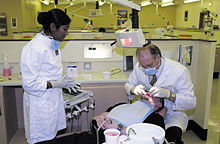Elbow

An elbow ( English contra-angle handpiece ) simplistically by the layman, drill called, is an angled preparation instrument with which the dentist or orthodontist is working in the mouth of the patient. The angle between the base and the head (see pictures) is normally 30 °. Different rotating instruments can be clamped into the head, depending on the operation . The shaft of these instruments has a diameter of either 2.35 mm ( RA shaft ( right-angle with manual locking)) or 1.6 mm ( FG shaft ( friction grip )).
Models
In addition to contra-angle handpiece heads that accommodate rotating instruments , contra-angle handpieces or contra-angle handpiece heads with other motion sequences are also available for special operations ( preparation of root canals ): stroke movement, reciprocal (alternating, changing) rotation with different rotation angles ( Giromatic ® contra- angle handpieces ) and combinations of stroke - and reciprocal rotational movements. Contra-angles with a torque limit or those that generate vibrations are also available.
In all modern dental devices, the contra-angle handpieces are attached directly to the electrically driven, maintenance-free micromotor . These couplings are standardized , so models from different manufacturers can be combined. The connection to the treatment unit, which controls the motor and supplies the contra-angles with compressed air and cooling water, is made by a hose. This control takes place either via a foot switch or by presetting.
Most contra-angle handpieces are equipped with light guides, the cold light source of which is integrated into the micromotor.
For the processing of bones in connection with implantations , special contra-angle handpieces with a particularly low speed and high torque are normally used. Infusion bottles with physiological saline solution can be connected to these for cooling.
Speeds
A micromotor normally delivers up to 40,000 min −1 (revolutions per minute). Through different translations on the elbow and his head a speed range up to a total of 200,000 min -1 covered.
The different ratios are indicated by color markings on the contra-angles:
| Color marking | Type | Ratio / reduction | Maximum speed |
|---|---|---|---|
| red | rotating quickly | 1: 5 | 200,000 min -1 |
| blue | turning normally | 1: 1 | 40,000 min -1 |
| green | turning slowly | 5.4: 1 | 7,400 min -1 |
| double green | turning very slowly | 14.8: 1 | 2,700 min -1 |
application
Depending on the work process, drills (e.g. round burs, fissure burs ), diamonds (actually: steel shafts equipped with diamond grains of different sizes and shapes), grinding tools ( corundum ) or rubber polishers can be clamped into the contra-angle handpiece. Milling cutters (according to Lindemann ) and internally cooled implant drills are used for surgical measures . Parapulpular pins are also screwed in by machine.
For excavating (removal of carious dentin ), a rotational speed between 1000 min -1 to 1500 min -1 suggested for preparing (grinding) of dental enamel and dentin for receiving a crown optionally selected maximum speed. It should be noted that the pulling power of the micromotor / contra-angle combination is significantly greater than that of a dental turbine .
For dental work (corrections) on dental prostheses , preference is given to a non-angled handpiece because it is more robust and the clamped instruments have a longer HP shaft ( hand piece ).
maintenance
The contra-angle handpiece must be sterilized after each use. To do this, the instrument is removed and the contra-angle handpiece is washed with water, oiled and then sterilized in a special bag in the autoclave . The instruments must be kept sterile until they are used again. Alcohol should not be used, as penetration breaks down the lubricants required for the mechanics and can lead to defects.
Hygiene regulations in Germany
The Robert Koch Institute issues hygiene guidelines for doctors and dentists based on legal requirements. It stipulates that instruments (contra-angle handpieces, turbines ) must be sterilized after each patient contact. The autoclaves used for sterilization must meet the EU standards EN 13060-1 and 13060-2, class B.
literature
- Paul Weikart: Materials science for dentists . 4th edition. Carl Hanser Verlag, Munich
Web links
- Construction and maintenance of contra-angle handpieces (PDF; 1.20 MB)



